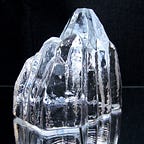The Glass Mountain
I was diagnosed with ADHD at the age of 59. I had a PhD and a job as a tenured professor, so it took a decade to convince my doctor to refer me to a psychiatrist for assessment. (“You can’t have ADHD, you’re so high-functioning!”)
The psychiatrist who assessed me said that at my age, the diagnosis “probably won’t make that much difference to your life.”
It made all the difference.
I felt as if, all my life, I’d been climbing a glass mountain, and slipping and falling and skinning my knees, bruising myself on the hard glass, and sliding back and losing all the territory I’d gained, getting up the mountain very painfully, slowly and awkwardly.
Meanwhile, all around me, crowds of people were just walking up the mountain. They were chatting and laughing, making steady progress, and they almost never stumbled or fell or slid back. Although we’d all started at the same time, they were way ahead of me, without bruises or scrapes.
I just didn’t get it. I knew I was pretty athletic. Or I thought I was, and people used to tell me I was. But all these other people, who didn’t look any stronger or more agile than I did, were surging up the mountain, passing me without panting or any sign of strain, not even breaking a sweat. What was my problem?
There were lots of people ready to tell me that my problem was that I just didn’t try hard enough. I just didn’t want to exert myself. Climbing is hard for everyone, and you have to put in the work. I had a problem, all right — I was lazy. My problem was that I was morally flawed.
I believed this. My problems were all my fault. I just needed to stop slacking and make more of an effort. And I tried, I really did. But it didn’t seem to help. I thought they must be right. I was just too lazy to make the effort. I hated myself.
And then one day I discovered that I was wearing slick leather-soled shoes.
That wasn’t exactly what I discovered. I knew I had slick leather soles — it was what I’d always had. Doesn’t everybody? This was normal, right?
What I discovered was that this wasn’t normal.
Everyone else on the mountain had thick crepe-soled shoes that gripped the glass. I didn’t even know those things existed. And everyone had them, except me.
So while I was slipping and floundering, and weeping, and falling and bruising myself, and getting up and trying again, and wondering what was wrong with me, and why I couldn’t do what everyone else could apparently do so easily, everyone else was running up the mountain on their crepe-soled shoes.
That is what diagnosis felt like.
It didn’t come with new shoes. But at least now I knew what the problem was. And I knew that the problem wasn’t me.
(1)
